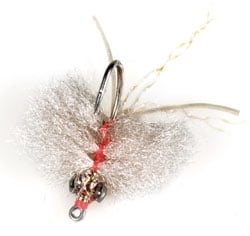
For fly-fishermen of the Southern California surf, spring signals the beginning of corbina season. These fish represent the most challenging sight-casting quarry in our area, and most who are bitten by the corbina bug develop nothing short of a lifelong addiction.
Corbina are found throughout the surf year-round, but spring and summer bring them in large numbers to feed on beds of Pacific mole crabs. Along with the sand, these crabs are transported back to shore this time of year. Juvenile beds consist of tiny, rice-sized crabs that grow throughout the summer. Adult-sized crabs are also present, and they represent a much larger morsel to hungry corbina.
A corbina does not posses great vision; it relies instead on a barbel under its chin, which senses vibrations in the sand. When actively feeding on mole crabs, a corbina will constantly dig, root and suction up sand to dislodge the crabs and consume them.
Most sight-casting opportunities involve presentations to singles, pairs or groups of fish. Corbina tend to cruise along the edge of fixed structures, swooping in with an incoming surge to feed on a crab bed before recessing back to the structure. If no structure exists, they tend to slide up with an incoming surge and recess with the outgoing. This typically results in a short window of active feeding.
Corbina can certainly be caught on patterns mimicking everything from red worms to shrimp and baitfish, but their primary food source during the summer is mole crabs. For this reason, a mole-crab fly can be one of the more productive patterns in a surf fly-fisherman’s box. Over the years, the Surfin’ Merkin has evolved into a proven pattern for corbina in skinny water and even in deeper-water conditions. It has also been used successfully for other species, including perch, croaker and halibut.
My design is based on Del Brown’s famed permit crab fly, the Merkin. It is tied to represent a burrowing mole crab. After being dislodged from the sand, mole crabs swim backward and attempt to re-burrow, using two legs like paddles to kick backward. The females display an orange egg sack to the rear. Often, entire crab beds will pick up and move with the tide and current. The vibrations and displaced sand during such an event are like dinner bells for hungry corbina.
Anglers are often presented with a short window of opportunity when corbina actively feed in skinny water. To avoid scattering the spooky fish, fly-fishers must cast from a distance up the beach and try to land the fly as close to the fish as possible. These fish tend to suck up and spit out flies like Speedy Gonzales! Coupled with lateral current and a surging incoming tide, this presents a difficult environment for positioning flies in the zone.
The Surfin’ Merkin provides a great solution to many of these problems. The dumbbell eyes help get the bug quickly to the bottom, where they anchor the fly in the sand. They also keep the hook point riding up, which is crucial for maintaining a sharp point. Additionally, the forward weight makes the fly kick up sand like a burrowing mole crab.
The body material of this pattern provides a terrific cushion on impact, allowing for a very delicate presentation. With the legs splayed out in the rear, the fly produces a V-shaped wake in the sand when bounced along the bottom. Applying epoxy to the sand side of the fly allows it to be used repeatedly without falling apart due to abrasion. If the sink rate is too slow and the fish are not terribly spooky, one can simply trim the body material to reduce the fly’s buoyancy.
In the last few years, this fly has greatly improved our hookup rates because it allows us to get the bug closer to these finicky fish. We have dropped the Surfin’ Merkin on the nose of many corbina and still managed hookups that didn’t spook the group. Last summer I witnessed some of the longest follows I’ve ever seen from corbina; they never lost interest. Some fish chased the fly until they were nearly beached in a recessing tide. What’s more, some of the takes have been much more aggressive than on shrimp patterns – the fish occasionally suck in the bug along with an entire divot of sand!
Corbina may be as unpredictable as my wife in a shoe store, but the Surfin’ Merkin should help improve your odds. The sight of watching one of these fish break from the group, follow the bug, eat it and peel off line is truly spectacular! Is it summertime yet?
Materials
HOOK: Gamakatsu SL11-3H #8 to #6.
THREAD: UTC 140 Fl, fire orange.
EYES: Black Dazl Eyes 1/8″ to 5/32″.
LEGS: Doug’s Bugs gray-pearl Slither Legs and three to four strands of UV Krystal Flash.
BODY: Silver-gray EP Fibers.
HEAD: Six strands of Doug’s Bugs hot-orange Electra Flash.
EPOXY COAT: Tuffleye, then a coat of Hard as Nails.
| Step 1: Tie in the dumbbell eyes near the front of the hook with tight figure-eight wraps. Cinch the wraps down to the hook shank by wrapping the thread parallel to the shank at the base of the eyes. This pulls the thread even tighter and helps keep the eyes from spinning. Coat with head cement to lock things in place. |
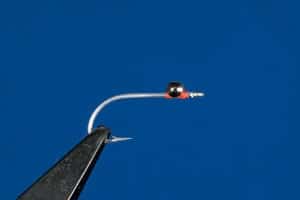
| |Step 2: Wrap the thread to the back of the hook shank. Tie in the Slither Legs and wrap successive wraps tighter while positioning the legs to splay into a V shape. Add four strands of UV Krystal Flash in the center, slightly longer than the Slither Legs.|
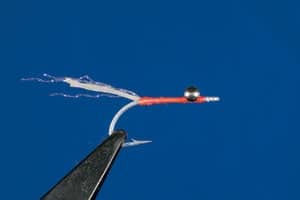
| |Step 3: Rotate the hook upside down and tie in successive clumps of silver-gray EP Fiber. I loosely figure-eight wrap the bundle and push it back on the hook shank into position. Then I cinch down the figure-eight wrap with a couple wraps in front of the bundle. This allows you to get the bundle roughly attached to the shank without having to fight the previous bundle’s fibers.|
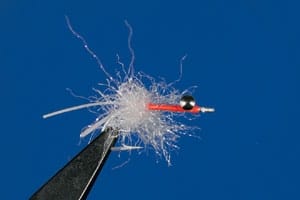
| |Step 4: Tie enough bundles to get near the dumbbell eyes. Usually three to four bundles is enough on a size-8 hook. Trim the fly into shape using scissors, and avoid cutting the legs. I typically trim size-8 flies to the size of a nickel and size-6 flies to the size of a quarter. Rotate the hook right-side up and tie in six strands of orange Electra Flash just behind the dumbbell eyes. Move the thread near the eye of the hook and wrap the dumbbell eyes with the Electra Flash. This represents the egg sack of a female mole crab. Tie off the fly with a few half hitches.|
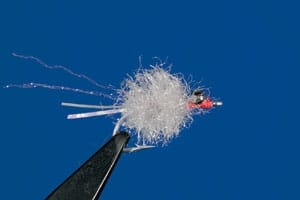
| |Step 5: Using your fingers, push the fibers down toward the hook point, coat the top of the hook shank and the dumbbell eyes with Tuffleye and cure with their light. Remove the tacky layer with rubbing alcohol and coat with Hard as Nails. This provides a protective layer against abrasion in the sand. It also helps hold the fibers in their proper orientation and will stay clear over time.|
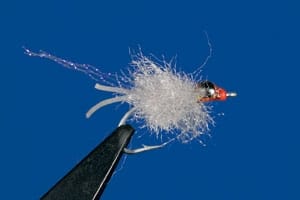
|









